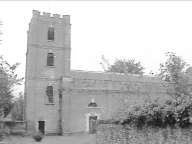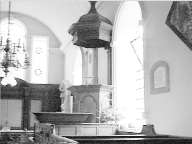![]()

![]()
13. St Mary's Avington

Avington is situated in idyllic countryside on the south bank of the river Itchen halfway between Alresford and Winchester. It is one of the smallest parishes in Hampshire. St Mary's comes as a great surprise since it is that rarity, an unrestored red-bricked Georgian church built between 1768-71.
The pathway from the road to the church with its dominating embattled tower, is 100 yards long and made up of old tombstones which lie like stepping stones in the grass. Inside there is a marvellous sense of light enhanced by the barrel ceiling of the nave painted an attractive light blue. All the windows are of plain glass, apart from a small Crucifixion scene in the East window with four roundels alongside depicting Wheat (the Bread of Life), a Rose, Grapes and a Lily. The blue reredos behind the altar has the Creed, the Lord's Prayer and the Ten Commandments written on it in gold lettering.

A great three decker pulpit capped by a carved dove dominates the nave. It is made of Spanish mahogany taken from an Armada galleon captured by the Duke of Effingham. The rest of the nave is filled by high boxed pews, each with seats on four sides facing the middle. The largest, with padded cushions and carved interior, was reserved for the Manor House. It even has its own wall pegs for hanging wigs on. At the west end the marble font is of unusual vase shape. Above it is a musician's gallery, with two rows of seats for the musicians and a barrel organ dating from 1830. Hanging from the gallery are the Arms of King George III dated 1771.
Two memorials deserve mention. One is to John Shelley, brother of the famous poet Percy Bysshe Shelley. He purchased the estate in 1848. In the small churchyard across the road is an impressive tomb to some twenty members of the Shelley family.
Then on the north side of the chancel is a typical eighteenth century memorial epitaph to Margaret Marchioness of Carnarvon (1734-68), who gave the money for the building of the church "tho it pleafed God to remove her to a better World a few Monthes before it was began." After listing her many virtues comes this heart rending appeal... "But Reader Commiferate not her Fate (who doubtlefs is now completely bleft) but the unhappy Hufband in Lofing in the Prime of life the Virtuous Partner of his Bed and Heart - Beft of Women! Most unfortunate of Men."
This unhappy husband was James Brydger Third Duke of Chandos. He rebuilt Little Stanmore church in Middlesex in 1715 and employed Handel as his Kapellmeister for two years. The Chandos anthems are dedicated to him. St Mary's is closely modelled on the Stanmore church.
Country Churches written by John Symonds
![]() Return to the November 1997 Features page
Return to the November 1997 Features page
![]() return to Home page and main index
return to Home page and main index
page last updated 2 NOVEMBER 1997